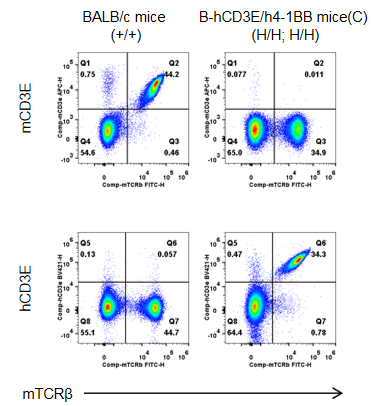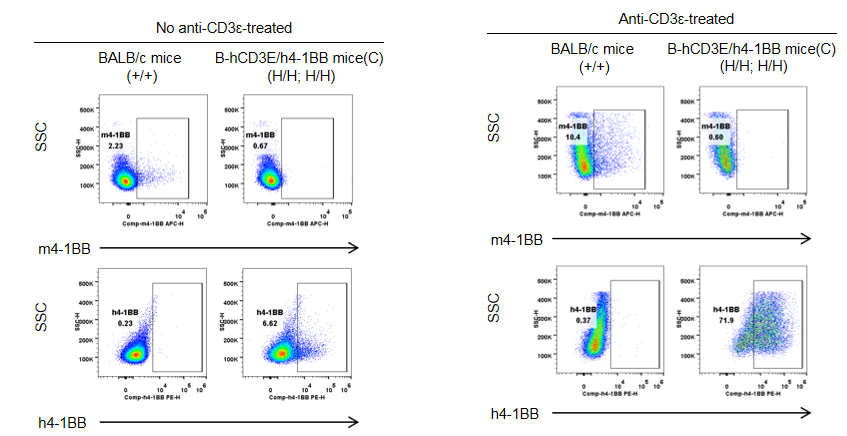


BALB/cCrSlcNifdc-Cd3etm1(CD3E)BcgenTnfrsf9tm1(TNFRSF9)Bcgen/Bcgen • 112903
| Product name | B-hCD3E/h4-1BB mice(C) |
|---|---|
| Catalog number | 112903 |
| Strain name | BALB/cCrSlcNifdc-Cd3etm1(CD3E)BcgenTnfrsf9tm1(TNFRSF9)Bcgen/Bcgen |
| Strain background | C57BL/6 |
| NCBI gene ID | 21942 |
| Aliases | CD3E, IMD18, T3E, TCRE,CD3e molecule;ILA,4-1BB,CD137,CDw137,MD109 |
Gene targeting strategy for B-hCD3E/h4-1BB mice(C).
The exons 2-6 of mouse Cd3e gene that encode the extracellular domain were replaced by human CD3E exons 2-7 in B-hCD3E/h4-1BB mice(C). The exons 2-7 of mouse 4-1bb gene that encode the extracellular domain were replaced by human 4-1BB exons 3-8 in B-hCD3E/h4-1BB mice(C).

Strain specific CD3E expression analysis in wild-type BALB/c mice and homozygous humanized B-hCD3E/h4-1BB mice(C) by flow cytometry. Splenocytes were collected from wild-type BALB/c mice (+/+) and homozygous B-hCD3E/h4-1BB mice(C) (H/H; H/H), and analyzed by flow cytometry. Mouse CD3E was only detectable in wild-type BALB/c mice. Human CD3E was exclusively detectable in homozygous B-hCD3E/h4-1BB mice(C), but not in wild-type BALB/c mice.

Strain specific 4-1BB expression analysis in wild-type BALB/c mice and homozygous humanized B-hCD3E/h4-1BB mice(C) by flow cytometry. Splenocytes were collected from wild-type BALB/c mice (+/+) and homozygous B-hCD3E/h4-1BB mice(C) (H/H; H/H) stimulated with anti-CD3ε in vivo, and analyzed by flow cytometry. Mouse 4-1BB was only detectable in wild-type BALB/c mice. Human h4-1BB was exclusively detectable in homozygous B-hCD3E/h4-1BB mice(C), but not in wild-type BALB/c mice.